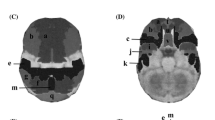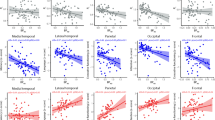Abstract
The Alzheimer Disease Assessment Scale (Japanese version) cognitive subscale (ADAS-Jcog) is composed of a number of subscale tasks. However, it is not clear which subscale tasks are most susceptible to impairment in Alzheimer’s disease (AD) or what is the relationship between reduction in regional cerebral blood flow (rCBF) and decreased ADAS-Jcog scores. Subjects were 32 AD patients, aged 52–86 years. We examined the relationship between subscale tasks that showed marked score changes and brain regions that showed reduced rCBF over a 2-year period. rCBF was measured by single-photon emission computed tomography (SPECT) with technetium-99m ethyl cysteinate dimer (99mTc-ECD), and the SPECT imaging data were analyzed with the easy Z-score imaging system (eZIS) and voxel-based stereotactic extraction estimation (vbSEE) methods. Total score of ADAS-Jcog deteriorated from 19.5 ± 7.0 to 35.7 ± 15.2 after 2 years. Subscale scores were significantly worse in all fields, particularly in orientation, word recall, remembering test instructions, commands, constructional praxis, and ideational praxis, in that order. Significant correlations were found between (1) word recall and commands and rCBF in the left middle temporal lobe, (2) naming objects/fingers and rCBF in the left temporal (middle, inferior) lobe, and (3) constructional and ideational praxis and rCBF in the right parietal (superior, inferior) lobe, temporal (superior, middle) lobe, angular gyrus, and cingulate gyrus. We identified the brain regions associated with specifically impaired subscales of ADAS-Jcog during progressive deterioration of AD over 2 years.





Similar content being viewed by others
References
Dubois B, Feldman HH, Jacova C, Cummings JL, DeKosky ST, Barberger-Gateau P, Delacourte A, Frisoni G, Fox NC, Galasko D, Gauthier S, Hampel H, Jicha GA, Meguro K, O’Brien J, Pasquier F, Robert P, Rossor M, Salloway S, Sarazin M, de Souza LC, Stern Y, Visser PJ, Scheltens P (2010) Revising the definition of Alzheimer’s disease: a new lexicon. Lancet Neurol 9:1118–1127
Todd S, Barr S, Roberts M, Passmore AP (2013) Survival in dementia and predictors of mortality: a review. Int J Geriatr Psychiatry 28:1109–1124
Mohs RC, Rosen WG, Davis KL (1983) The Alzheimer’s disease assessment scale: an instrument for assessing treatment efficacy. Psychopharmacol Bull 19:448–450
Zec RF, Landreth ES, Vicari SK, Belman J, Feldman E, Andrise A, Robbs R, Becker R, Kumar V (1992) Alzheimer disease assessment scale: a subtest analysis. Alzheimer Dis Assoc Disord 6:164–181
Graham DP, Cully JA, Snow AL, Massman P, Doody R (2004) The Alzheimer’s disease assessment scale-cognitive subscale: normative data for older adult controls. Alzheimer Dis Assoc Disord 18:236–240
Kramer-Ginsberg E, Mohs RC, Aryan M, Lobel D, Silverman J, Davidson M, Davis KL (1998) Clinical predictors of course for Alzheimer patients in a longitudinal study: a preliminary report. Psychopharmacol Bull 24:458–462
Matsuda H (2007) Role of neuroimaging in Alzheimer’s disease, with emphasis on brain perfusion SPECT. J Nucl Med 48:1289–1300
Homma A (1992) Assessment and treatment of patients with dementia of the Alzheimer type. Nihon Ronen Igakkai Zasshi 29:264–270
Verma N, Beretvas SN, Pascual B, Masdeu JC, Markey MK, Alzheimer’s Disease Neuroimaging Initiative (2015) New scoring methodology improves the sensitivity of the Alzheimer’s Disease Assessment Scale-Cognitive subscale (ADAS-Cog) in clinical trials. Alzheimers Res Ther 7:64
Förstl H, Kurz A (1999) Clinical features of Alzheimer’s disease. Eur Arch Psychiatry Clin Neurosci 249:288–290
Jobst KA, Barnetson LP, Shepstone BJ (1997) Accurate prediction of histologically confirmed Alzheimer’s disease and the differential diagnosis of dementia: the use of NINCDS-ADRDA and DSM-III-R criteria, SPECT, X-ray CT, and APO E4 medial temporal lobe dementias. The Oxford Project to Investigate Memory and Aging Int Psychogeriatr Suppl 1: 191–222; discussion 247-252
Nebu A, Ikeda M, Fukuhara R, Shigenobu K, Maki N, Hokoishi K, Komori K, Yasuoka T, Tanabe H (2001) Relationship between blood flow kinetics and severity of Alzheimer’s disease: assessment of severity using a questionnaire-type examination, Alzheimer’s disease assessment scale, cognitive sub-scale (ADAS(cog)). Dement Geriatr Cogn Disord 12:318–325
Hanyu H, Sato T, Hirao K, Kanetaka H, Iwamoto T, Koizumi K (2010) The progression of cognitive deterioration and regional cerebral blood flow patterns in Alzheimer’s disease: a longitudinal SPECT study. J Neurol Sci 290:96–101
Ishii K, Kawachi T, Sasaki H, Kono AK, Fukuda T, Kojima Y, Mori E (2005) Voxel-based morphometric comparison between early- and late-onset mild Alzheimer’s disease and assessment of diagnostic performance of z score images. AJNR Am J Neuroradiol 26:333–340
Möller C, Vrenken H, Jiskoot L, Versteeg A, Barkhof F, Scheltens P, van der Flier WM (2013) Different patterns of gray matter atrophy in early- and late-onset Alzheimer’s disease. Neurobiol Aging 34:2014–2022
Kim EJ, Cho SS, Jeong Y, Park KC, Kang SJ, Kang E, Kim SE, Lee KH, Na DL (2005) Glucose metabolism in early onset versus late onset Alzheimer’s disease: an SPM analysis of 120 patients. Brain 128:1790–1801
Miners JS, Palmer JC, Love S (2016) Pathophysiology of hypoperfusion of the precuneus in early Alzheimer’s disease. Brain Pathol 26:533–541
Sakamoto S, Ishii K, Sasaki M, Hosaka K, Mori T, Matsui M, Hirano N, Mori E (2002) Differences in cerebral metabolic impairment between early and late onset types of Alzheimer’s disease. J Neurol Sci 200:27–32
Rodriguez G, Morbelli S, Brugnolo A, Calvini P, Girtler N, Piccardo A, Dougall NJ, Ebmeier KP, Baron JC, Nobili F (2005) Global cognitive impairment should be taken into account in SPECT-neuropsychology correlations: the example of verbal memory in very mild Alzheimer’s disease. Eur J Nucl Med Mol Imaging 32:1186–1192
Takahashi M, Oda Y, Okubo T, Shirayama Y (2017) Relationships between cognitive impairment on ADAS-cog and regional cerebral blood flow using SPECT in late-onset Alzheimer’s disease. J Neural Transm (Vienna) 124:1109–1121. https://doi.org/10.1007/s00702-017-1734-7
Leech R, Sharp DJ (2014) The role of the posterior cingulate cortex in cognition and disease. Brain 137(Pt 1):12–32
Kaiser NC, Melrose RJ, Liu C, Sultzer DL, Jimenez E, Su M, Monserratt L, Mendez MF (2012) Neuropsychological and neuroimaging markers in early versus late-onset Alzheimer’s disease. Am J Alzheimers Dis Other Demen 27:520–529
Green RC, Goldstein FC, Mirra SS, Alazraki NP, Baxt JL, Bakay RA (1995) Slowly progressive apraxia in Alzheimer’s disease. J Neurol Neurosurg Psychiatry 59:312–315
Bartenstein P, Minoshima S, Hirsch C, Buch K, Willoch F, Mösch D, Schad D, Schwaiger M, Kurz A (1997) Quantitative assessment of cerebral blood flow in patients with Alzheimer’s disease by SPECT. J Nucl Med 38:1095–1101
Nobili F, Brugnolo A, Calvini P, Copello F, De Leo C, Girtler N, Morbelli S, Piccardo A, Vitali P, Rodriguez G (2005) Resting SPECT-neuropsychology correlation in very mild Alzheimer’s disease. Clin Neurophysiol 116:364–375
Nielson KA, Cummings BJ, Cotman CW (1996) Constructional apraxia in Alzheimer’s disease correlates with neuritic neuropathology in occipital cortex. Brain Res 741:284–293
Smith MZ, Esiri MM, Barnetson L, King E, Nagy Z (2001) Constructional apraxia in Alzheimer’s disease: association with occipital lobe pathology and accelerated cognitive decline. Dement Geriatr Cogn Disord 12:281–288
Acknowledgements
We thank Mrs. Isa Yoshinari at the Department of Neurology, Saiseikai Shonan Hiratsuka Hospital, for her technical assistance.
Author information
Authors and Affiliations
Corresponding author
Ethics declarations
Conflict of interest
The authors declare that they have no conflicts of interest.
Ethical approval
All procedures performed in our study were in accordance with the ethical standards of institutional research committee and with the 1964 Helsinki declaration and its later amendments or comparable ethical standards. All authors hereby declare that submission of this manuscript for publication has been approved by Saiseikai Shonan Hiratsuka Hospital and Tokai University Oiso Hospital.
Rights and permissions
About this article
Cite this article
Yoshii, F., Kawaguchi, C., Kohara, S. et al. Characteristic deterioration of ADAS-Jcog subscale scores and correlations with regional cerebral blood flow reductions in Alzheimer’s disease. Neurol Sci 39, 909–918 (2018). https://doi.org/10.1007/s10072-018-3277-6
Received:
Accepted:
Published:
Issue Date:
DOI: https://doi.org/10.1007/s10072-018-3277-6




